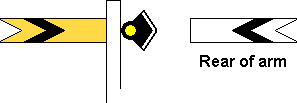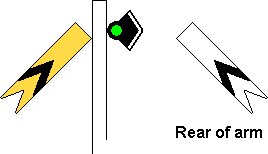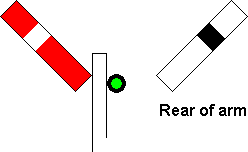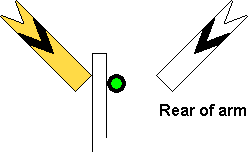|
|
|
|
|
|
|
|
|
Some of the earliest colour light signals were installed not as part of a complete resignalling scheme but as replacements for individual semaphore signals. In such cases, the new colour light signals generally displayed aspects identical to those formerly shown by the semaphore signals at night. Accordingly, a colour light stop signal could display either red for 'danger' or green for 'clear', and a colour light distant signal showed either yellow for 'caution' or green for 'clear'. Where a semaphore signal with stop and distant arms mounted together on the same post (see [2.33 - 2.35]) was renewed in directly equivalent colour light form, the colour light signal comprised two signal heads, the stop signal head being positioned above the distant signal head. With this combination of signal heads, the 'danger' aspect was red over yellow [2.109], the 'caution' aspect was green over yellow [2.110], and the 'clear' aspect was green over green [2.111].
 |
 |
 |
|
[2.109] Red Aspect over Yellow Aspect.
Area: Predominantly GWR Usage: High Status: Historical |
[2.110] Green Aspect over Yellow Aspect.
Area: Predominantly GWR Usage: High Status: Historical |
[2.111] Green Aspect over Green Aspect.
Area: Predominantly GWR Usage: High Status: Historical |
|---|
The provision of yellow arms and lights on semaphore distant signals became a requirement of the Ministry of Transport in 1925. This rendered superfluous the Coligny-Welch lamps used on some railways (see [2.66 - 2.69]). The Locomotive Department of the Southern Railway objected to their removal, however, and in some cases they were retained for a period after yellow arms had been fitted [2.112 & 2.113]. There was even a suggestion that the colour of the chevron light should be altered from white to yellow when the new arms were fitted, but this was not done. The Southern Railway finally abolished its Coligny-Welch lamps in 1927.
 |
 |
|
[2.112] Semaphore Distant Signal with Yellow Arm and Coligny-Welch Lamp ('on').
Area: Southern Railway Usage: Medium Status: Historical |
[2.113] Semaphore Distant Signal with Yellow Arm and Coligny-Welch Lamp ('off').
Area: Southern Railway Usage: Medium Status: Historical |
|---|
The IRSE's Three-Position Signalling Committee report, published in 1924, had included a recommendation that all future three-aspect signals should be of the colour light type, as opposed to three-position semaphores. This would leave the way open for the introduction of two-position upper quadrant semaphore signals, which have arms that are raised through 45° for the 'off' position [2.114 & 2.115], making them less susceptible to 'wrong side' failures than the lower quadrant signals formerly installed. The adoption of the upper quadrant semaphore signal was agreed to at a meeting of the Railway Clearing House on 20 July 1926. The 1928 issue of the MoT 'Requirements' no longer dictated that semaphore arms must operate in the lower quadrant, as the previous issue had done in 1925. The Great Western Railway (and subsequently the Western Region of BR) resisted any move towards adopting the upper quadrant signal and continued to install lower quadrant signals, almost exclusively.
 |
 |
|
[2.114] Upper Quadrant Semaphore Stop Signal ('off').
Area: All Areas Usage: High Status: Current |
[2.115] Upper Quadrant Semaphore Distant Signal ('off').
Area: All Areas Usage: High Status: Current |
|---|
In August 1929, the arms of two banner distant signals between Higham and Strood (Southern Railway) were altered from red to yellow, and their background colour was changed to black [2.116 & 2.117].
 |
 |
|
[2.116] Banner Distant Signal with Yellow Arm ('on').
Area: Southern Railway Usage: Low Status: Historical |
[2.117] Banner Distant Signal with Yellow Arm ('off').
Area: Southern Railway Usage: Low Status: Historical |
|---|
Apart from an early installation on the Engine and Carriage lines between London Paddington and Old Oak Common in December 1928, the Great Western Railway chose not to install any three-aspect or four-aspect colour light signals in the form that became standard on the SR, the LMS and the LNER. Colour light signals installed on the GWR from 1931 displayed aspects that were the same as those shown by semaphore signals at night, including stop signal heads mounted above distant signal heads on the same post (see [2.109 - 2.111]). The last of these two-headed colour light signals, at Bristol, were removed in the early 1970s.
A F Bound, in his new position as Signal Engineer of the LMS, devised a system of colour light signalling which was installed from June 1932 on the electrified lines between Camden and Watford Junction ('New' Line) and in September 1932 on the Local lines between Barking and Upminster. The main aspects included were the red aspect, yellow aspect, green aspect and a small number of double yellow aspects. Bound, who had visited the United States in 1931, incorporated an element of North American practice in the form of marker lights, despite a recommendation against using these having been included in the report of the IRSE's Three-Position Signalling Committee in which he had served as Chairman. Since publication of the report in 1924, the rising use of colour light signals in nominally semaphore territory had convinced Bound of the need to distinguish signals within 'multiple-aspect colour light signal' territory by providing marker lights on the latter. Any signal that read towards a semaphore signal or a London Transport signal was not provided with a marker light. The marker light fitted to a stop signal comprised a red light mounted lower down the post, vertically below the main aspect [2.118 - 2.120]. It remained illuminated except when the main signal was displaying a 'clear' aspect (see [2.107]) or when a subsidiary aspect was displayed (see Section 3).
 |
 |
 |
|
[2.118] Red Aspect with Marker Light.
Area: LMS Usage: High Status: Historical |
[2.119] Single Yellow Aspect with Marker Light.
Area: LMS Usage: Medium Status: Historical |
[2.120] Double Yellow Aspect with Marker Light.
Area: LMS Usage: Medium Status: Historical |
|---|
Since most of the stop signals on the Camden - Watford line were spaced well in excess of the required braking distance, a repeater signal was usually provided at braking distance on the approach to a stop signal. The line was equipped with a permissive working facility, which necessitated each repeater signal being able to display a red aspect. The marker lights on repeater signals were offset to the left [2.121 & 2.122] to distinguish them from stop signals. After stopping at a repeater signal displaying a 'danger' aspect, the driver was permitted to proceed cautiously past it after waiting for one minute.
 |
 |
|
[2.121] Red Aspect with offset Marker Light.
Area: Watford New Line, LMS Usage: Medium Status: Historical |
[2.122] Single Yellow Aspect with offset Marker Light.
Area: Watford New Line, LMS Usage: Medium Status: Historical |
|---|
In July 1932, Bound's experimental colour light signalling scheme in the Mirfield area was commissioned. Red marker lights were also used here on all colour light signals apart from those that read towards a semaphore signal. Where provided, the marker light was positioned vertically below the main aspect (see [2.118]), and it remained illuminated except when the main signal was displaying a 'clear' aspect or when a shunting or subsidiary aspect was displayed. One of the unique features of the Mirfield scheme was the inclusion of a fifth main signal aspect, yellow over green. Inserted into the normal aspect sequence between the green aspect and the double yellow aspect where signals were closely spaced, the yellow over green aspect meant "attention - pass second signal at restricted speed". The marker light, as well as being lit together with a single yellow or a double yellow aspect (see [2.119 & 2.120]), was also illuminated when a yellow over green aspect was displayed [2.123].
Bound's resignalling at Glasgow St. Enoch in May 1933 was the fourth and final scheme to feature red marker lights. This installation had no double yellow or yellow over green aspects. Also in 1933, discussions on the standardisation of colour light signals commenced at the instigation of the Ministry of Transport, and this led the LMS to discontinue its practice of providing marker lights on signals for future installations. The four signalling schemes already equipped with marker lights retained them for the lifetime of each installation. Around 1936/1937, however, the operation of the existing marker lights was altered so that they were only illuminated while the corresponding main signal was displaying a 'danger' aspect (and no subsidiary aspect was displayed). Marker lights ceased being illuminated in conjunction with any main 'proceed' aspect, except at junction signals that conformed to speed signalling principles, where they stayed lit as before (see [6.34 & 6.35]). This alteration included the yellow over green aspects in the Mirfield area [2.124], but these aspects were abolished early in 1959 in favour of double yellow aspects being displayed at consecutive signals. Although the unusual signalling installation at Mirfield was decommissioned in May 1970, the last of Bound's marker lights were abolished in December 1988, when the 'New' Line between Camden and Watford was resignalled with conventional colour light signals.
 |
 |
|
[2.123] Yellow over Green Aspect with Marker Light.
Area: Mirfield, LMS Usage: Medium Status: Historical |
[2.124] Yellow over Green Aspect.
Area: Mirfield, LMS Usage: Medium Status: Historical |
|---|
|
|
|